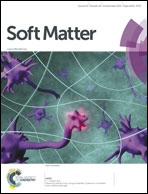The effect of position of (S)-2-octyloxy tail on the formation of frustrated blue phase and antiferroelectric phase in Schiff base liquid crystals†
Abstract
Two series of chiral salicylaldimine-based liquid crystals which differ from each other in the position of the (S)-2-octyloxy tail have been synthesized and characterized by polarizing optical microscopy, differential scanning calorimetry, and electrical switching. Compounds OH I (n = 6–7) having (S)-2-octyloxy tail close to the salicylaldimine core and compounds OH II (n = 6–11) having (S)-2-octyloxy tail far from the salicylaldimine core exhibit polymorphism of mesophases including frustrated blue phase and antiferroelectric (SmC*A) phases. Notably, as compared with structurally similar Schiff base compounds H I (n = 7), intramolecular hydrogen bonding in antiferroelectric salicylaldimine-based compounds OH I (n = 7) induces the frustrated blue phase. However, as compared with structurally similar Schiff base compounds OH II (n = 8), the lack of intramolecular hydrogen bonding in Schiff base compounds H II (n = 8) suppresses antiferroelectric properties.


 Please wait while we load your content...
Please wait while we load your content...